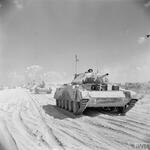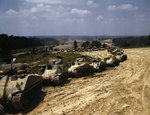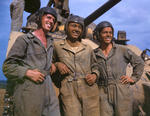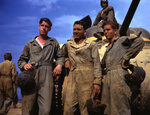M4 Sherman
| Country | United States |
| Primary Role | Medium Tank |
Contributor: C. Peter Chen
ww2dbaseOn 31 Aug 1940, the United States Army Ordnance Department submitted the M4 tank design as a potential replacement for the existing M3 tanks. It was approved on 18 Apr 1941 as the prototype promised a tank that was as capable as the successful German tanks. The first model was completed on 2 Sep 1941, and the design entered full production in Feb 1942, three months after the United States entered WW2.
ww2dbaseDuring the war, the M4 tanks, now nicknamed "Sherman" by the British, served with the United States with its Army and Marine Corps, and also with several Allied nations, notably Britain and Canada, and with the Soviet forces. The first American Sherman tanks in combat were of the M4A1 variant that landed in North Africa in Nov 1942 during Operation Torch, although the British had already saw combat with them a month before at the Second Battle of El Alamein in Egypt. They were extremely effective with high top speed, adequate armor to stop smaller caliber anti-tank guns, and weapons capable of penetrating German armor. Through the Desert War, they slowly replaced their predecessor, the M3 Lee tanks, as the main medium tank of the United States Army. After the invasion of Normandy in Jun 1944, it was discovered that the 75-millimeter guns found in earlier Sherman tanks were ineffective against new German tank types, namely the Panther and Tiger models, and two new variants were produced, one with the new high velocity 76-millimeter M1 guns and the other with a 90-millimeter M3 guns. Despite the upgrades, however, the armament of Sherman tanks were still far inferior to the Panther tanks' 75-millimeter gun, only effective against Panther tanks at close range, which led to the high loss rate at the start of the Normandy Campaign. In Jul 1944, the hypervelocity armor piercing (HVAP) ammunition entered mass production as M93 and became the standard armor piercing ammunition, which eased the situation slightly, but limited production meant only tank destroyer units received them. By the end of the European War, half of the US Army tanks in this theater were M4 Sherman tanks.
ww2dbaseWhile Americans developed more lethal rounds to improve the M4 Sherman tanks, the British took a different approach. Royal Tank Regiment Major George Brighty led an effort to modify certain batches of M4 Sherman tanks, particularly the M4 (Sherman I) and M4A4 (Sherman V) variants, so that they would carry the larger caliber 17-pounder guns. The end result were the Sherman Firefly tanks, which effectively became the most powerfully gunned Allied tanks of World War II, capable of dueling the feared German Panther and Tiger tanks. Sherman Firefly tanks were first used by British and Commonwealth units on 6 Jun 1944 at the Normandy landings, and were used until the end of the European War.
ww2dbaseIn the Pacific War, where tank battles were few and far in-between, the M4 Sherman tanks easily out-classed their Japanese counterparts. Unlike their North African and European counterparts, the Sherman tanks deployed to the Pacific often used high explosive rounds instead of armor piercing rounds; the decision was made due to the reason that the Japanese tanks were thinly-armored, and armor piercing rounds often went through the tank without detonating the explosives. The armor piercing rounds, though, remained effective against defensive fortifications. Rather unique in the Pacific theater was the deployment of Sherman tanks that were equipped with flamethrowers, which were seen in the European War but the usage was limited. The M4 Sherman design had a escape hatch at the bottom of the hull, originally placed to provide another route of escape should the tank become disabled. This hatch gained an alternative use in the Pacific War as a method of recovering the wounded as Japanese snipers frequently targeted Americans dispatched to treat them.
ww2dbaseNotable weaknesses of the M4 Sherman tanks include the ease for earlier variants to catch fire when struck by enemy armor piercing rounds. Despite this negative characteristic, the majority of Sherman tank losses were not attributed to duels with enemy vehicles; rather, they were more often lost to mines, aircraft, and infantry anti-tank weapons. They were also known for their difficulty when traversing across soft terrain, such as snow or mud, due to the narrow width. To remedy this weakness, Soviet tank crews modified the tracks for better grip.
ww2dbaseAfter the war, the US Army continued to employ Sherman tanks of the M4A3E8 variant, equipped with either 76-millimeter guns or 105-millimeter howitzers. They saw action in the Korean War despite new tank models had already entered service. During the M4 Sherman design's production life, over 50,000 units were built.
ww2dbaseSources: Sherman Firefly, Wikipedia.
Last Major Revision: Jan 2008
SPECIFICATIONS
M4(105)
| Machinery | One Continental R975 C1 gasoline engine rated at 400hp |
| Suspension | Vertical Volute Spring Suspension |
| Armament | 1x105mm howitzer, 1x12.7mm Browning M2HB machine gun, 2x7.82mm Browning M1919A4 machine guns |
| Armor | 19-91mm |
| Crew | 5 |
| Length | 5.84 m |
| Width | 2.62 m |
| Height | 2.74 m |
| Weight | 30.0 t |
| Speed | 24 km/h |
| Range | 193 km |
M4A3E8(76)W
| Machinery | One Ford GAA V8 gasoline engine |
| Suspension | Vertical Volute Spring Suspension |
| Armament | 1x76mm M1 gun, 1x12.7mm Browning M2HB machine gun, 2x7.82mm Browning M1919A4 machine guns |
| Armor | 19-91mm |
| Crew | 5 |
| Length | 5.84 m |
| Width | 2.62 m |
| Height | 2.74 m |
| Weight | 30.0 t |
| Speed | 24 km/h |
| Range | 193 km |
M4A2
| Machinery | One GM 6046 2x6 diesel engine |
| Suspension | Vertical Volute Spring Suspension |
| Armament | 1x75 mm M3 L/40 gun (90 rounds), 1x12.7mm Browning M2HB machine gun, 2x7.82mm Browning M1919A4 machine guns |
| Armor | 19-91mm |
| Crew | 5 |
| Length | 5.84 m |
| Width | 2.62 m |
| Height | 2.74 m |
| Weight | 30.0 t |
| Speed | 24 km/h |
| Range | 193 km |
M4A1
| Machinery | One Continental R975 C1 gasoline engine rated at 400hp |
| Suspension | Vertical Volute Spring Suspension |
| Armament | 1x75 mm M3 L/40 gun (90 rounds), 1x12.7mm Browning M2HB machine gun, 2x7.82mm Browning M1919A4 machine guns |
| Armor | 12-75mm |
| Crew | 5 |
| Length | 5.84 m |
| Width | 2.62 m |
| Height | 2.74 m |
| Weight | 33.0 t |
| Speed | 39 km/h |
| Range | 193 km |
Photographs
 |  |  |  |
Please consider supporting us on Patreon. Even $1 per month will go a long way! Thank you. Please help us spread the word: Stay updated with WW2DB: |
Visitor Submitted Comments
9 Jun 2014 11:29:19 PM
The "Ronson" nickname is a common myth, but it is a myth - only Sherman flamethrower tanks were given the nickname "Ronson" during the war. The "first time, every time" slogan wasn't even used by the Ronson company until the 1950's. Shermans burned no more often than their German counterparts, and later Shermans, equipped with wet ammo stowage and with firm controls on the amount of ammo stowed in the turret were the LEAST flammable tanks of WWII.
20 Oct 2014 06:19:32 PM
The Canadian M4 shown in the black and white photo, top right in the article, rolled onto the beach at Juno on D-day and was in Germany on VE Day after 4000 km traveled and 6000 rounds fired. It didn't miss a day for any reason.
http://www.rifles23.com/BombTank.html
25 Apr 2015 05:55:11 PM
a ronson advertisment form 1929 http://www.amazon.com/Ronson-cigarette-lighter-Broadway-Limited/dp/B00LNHDO3E
you are the myth caspian.
29 Jun 2017 02:04:06 PM
This is incorrect; " The first American Sherman tanks in combat were of the M4A1 variant that landed in North Africa in Nov 1942 during Operation Torch, although the British had already saw combat with them a month before at the Second Battle of El Alamein in Egypt. "
31 Aug 2017 08:16:40 AM
Sneak preview video-
Army veteran’s new book on the Sherman Tank Scandal of WWII:
https://www.forwantofagun.com/
All visitor submitted comments are opinions of those making the submissions and do not reflect views of WW2DB.
» Panther vs. Sherman: Battle of the Bulge 1944
» Sherman Firefly
- » 1,167 biographies
- » 337 events
- » 44,606 timeline entries
- » 1,243 ships
- » 350 aircraft models
- » 207 vehicle models
- » 376 weapon models
- » 123 historical documents
- » 261 facilities
- » 470 book reviews
- » 28,499 photos
- » 365 maps
Winston Churchill, on the RAF
Please consider supporting us on Patreon. Even $1 a month will go a long way. Thank you!
Or, please support us by purchasing some WW2DB merchandise at TeeSpring, Thank you!
6 Mar 2014 07:49:21 PM
this was good information, but it does need more info on the battles they were used in and how they were used in those battles